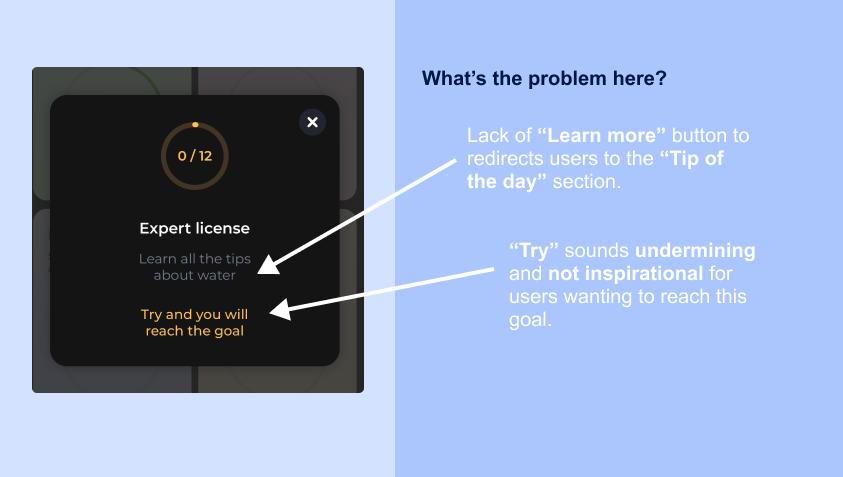I did a personal case study on the My Water app to solve the writing problem of its user interface, especially its call to action.
Scroll below to see how I localized the tone and voice of My Water to help users better navigate across the product.
Introduction
As a frequent user of My Water, an app that helps users understand their water intake and encourages them to drink more water, I found numerous content across their user interface that could be better optimized for users' needs. The current content’s tone and voice come off as informal and dry, creating minimal impact on users. Therefore, this case study aimed to create a desirable voice and tone across the app that can be used to inspire and empower users to take action in the water intake journey.
Tone and voice chart
To optimize the My Water content across the app, I created a voice chart to improve the app's content strategy. This chart will help define a consistent voice throughout the app that will help motivate, inspire, foster diversity, and ultimately convert users to the app. By having the three content principles be Motivational, Show Improvement, and Body Diversity, the aspects (concepts, vocabulary, etc.) can be uniform and optimized to meet the needs of the app's mission and the users no matter who is creating the content. While there are plenty of good UX writing options, this voice chart makes it easier to decide between which options are most effective.
The problem
The solution
Additional findings
As I tested the app to understand the user experience and find areas to optimize content, I discovered how the UX writing for the Achievement section was not intuitive for users. In its current iteration, the short description makes it seem as if you could click the achievement tile and be redirected to the respective area to complete the goal, however, that is not the case. An information architecture redesign would be very effective in guiding users to appropriate content upon reading the short descriptions. The following steps were taken to revise the content to meet expected user actions:
The outcome
If My Water is to change its content strategy to enhance its copy, I believe adhering to a voice chart is an important first step for all teams handling communication with users. Not only does an established voice create better credibility with an audience, but it also helps solidify a uniform brand voice that increases their off-site SEO. The voice of My Water should also aid in the success of users' intended actions to create a good user experience that uplifts users, not confuse them.
As a result, I analyzed multiple sample call to action copies to see what worked and what did not. I found that by analyzing the copy, editing it, and referring to the voice chart and my users, I could craft an empowering call to action that consciously applied the three principles from the voice chart to make an effective message for a majority of the audience.
Project Roles:
Content Design
This table concept was created by Torrey Podmajersky in their book Strategic Writing for UX: Drive Engagement, Conversion, and Retention with Every Word.








